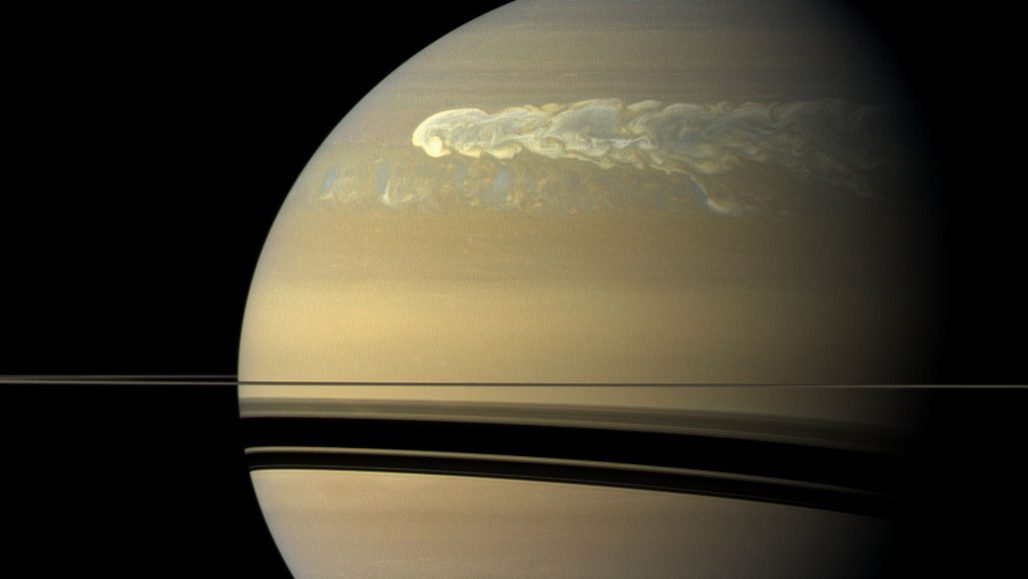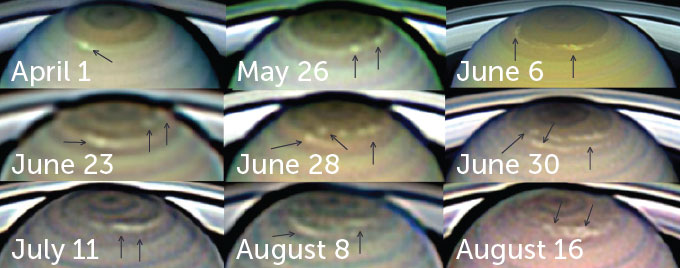Astronomers spot new type of storm on Saturn
Bigger than squalls, they are smaller than the planet’s massive Great White Spots

Pictured is a Great White Spot that raged in 2010 and 2011. Until now, astronomers had only seen Saturn ravaged by days-long small storms or by enormous, months-long Great White Spots. Now, astronomers have identified a third, midsize type on the planetary gas giant.
JPL-CALTECH/NASA, SSI
Saturn saw some weird weather last year. Telescope images revealed a newfound type of storm. It raged near the planet’s North Pole in 2018, researchers have just reported.
Until now, astronomers had seen only two types of storms on this gas giant. Some were relatively small, about 2,000 kilometers (about 1,250 miles) across. They appeared as bright clouds for a few days. More impressive have been Saturn’s Great White Spots. These rare tempests are 10 times as large and can rage for months. The newest phenomena are a series of four midsize storms. Each was somewhat bigger than the days-long storms, lasting between about 1.5 weeks and 7 months.
Saturn’s storms are thought to originate in water clouds hundreds of kilometers below the planet’s upper cloud cover. Studying these events can offer a window into deep atmospheric goings-on — ones that aren’t directly observable, says Agustín Sánchez-Lavega. He studies planetary atmospheres at the University of the Basque Country in Bilbao, Spain.
Sánchez-Lavega was part of a team that analyzed hundreds of telescope images. Some were taken by amateur astronomers. Others came from the Calar Alto Observatory in Spain and NASA’s Hubble Space Telescope. From late March to late October of last year, four unusual bright spots appeared in the atmosphere near Saturn’s North Pole. (That was between the latitudes of 67° N and 74° N.)
Triggering each midsize storm required about 10 times as much energy as would be needed to get a small storm going, computer models showed. However, mid-size storms took only about one-hundredth the energy needed to brew up a Great White Spot.
Sánchez-Lavega and his group described the new storms online October 21 in Nature Astronomy.
Still largely a mystery
The storm outbreak “almost leaves more questions than it can give answers,” says Georg Fischer. He’s a planetary scientist at the Space Research Institute of the Austrian Academy of Sciences in Graz. He was not involved in the new analysis.
The 2018 telescope images, for instance, don’t show whether the newfound storms crackled with lightning. Small storms typically boast a few flashes per minute. The more energetic Great White Spots flash several times a second. If similar midsize storms appear in the future, Fischer says, radio telescopes that monitor Saturn’s tempests for lightning could look for whether the middling storms are more similar to their small or to their giant counterparts. That might help scientists figure out how they form.
The timing of the 2018 storms hints that they might have been a failed Great White Spot. These planetary-scale storms have been observed only six times since 1876. Those few data points seem to indicate that Great White Spots form at around the same latitudes once every 60 years or so. The last time Saturn sported a far-north Great White Spot — near the latitudes where the 2018 storm quartet emerged — was 1960.

It’s possible that a 2010 Great White Spot that formed farther south took so much energy from Saturn’s atmosphere that there was only enough left to fuel a few middling storms last year, Sánchez-Lavega says.
But planetary scientist Robert West is skeptical that the 2010 Great White Spot could have interfered with storm activity so far north. He says that’s because gases swirling in Saturn’s atmosphere at different latitudes tend to stay in their own lanes. He instead suspects that last year’s storm sequence was not a failed Great White Spot, but “a whole different thing.” West, who was not part of the new study, works at Caltech and NASA’s Jet Propulsion Laboratory. Both are in Pasadena, Calif. For now, he says, the origins of those intermediate storms and how they relate to other weather phenomena on Saturn remain a mystery.







